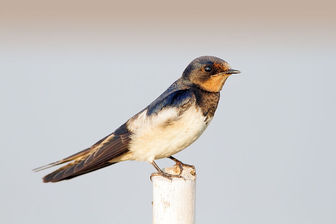Pacific Swallow
This species is a small swallow at 13 cm. It has a blue back with browner wings and tail, a red face and throat, and dusky underparts. It differs from Barn Swallow and the closely-related Welcome Swallow in its shorter and less forked tail.

Original source: Own work
Author: JJ Harrison (http://www.noodlesnacks.com/)Camera location
The Pacific Swallow is classified as Least Concern. Does not qualify for a more at risk category. Widespread and abundant taxa are included in this category.
* Pacific Swallow chicks have fledged 2 Lena Chow’s Pacific Swallow (Hirundo tahitica) chicks nesting at her... * Pacific Swallow feeding fledgling The nest of the Pacific Swallow (Hirundo tahitica) is... * Malayan Whistling Thrush: 3. Feeding the chicks The pair of Malayan Whistling Trush (Myophonus robinsoni) that nests... More
Pacific Swallow chicks have fledged 2 - Posted by BESG on 14 August 09, Friday Contributed by Lena Chow Lena Chow’s Pacific Swallow (Hirundo tahitica) chicks nesting at her office have fledged when about 20 days old - at 9.30am, 1 Aug. 2009. First one chick fledged, flying out of the nest accompanied by a parent. Then the other, also accompanied by a parent. More
The Pacific Swallow or Hill Swallow (Hirundo tahitica) is a small passerine bird in the swallow family. It breeds in tropical southern Asia from southern India and Sri Lanka across to south east Asia and the islands of the south Pacific. It is resident apart from some local seasonal movements. This bird is associated with coasts, but is increasingly spreading to forested uplands. HirundoTahiticaGould.jpg This species is a small swallow at 13 cm. More
Pacific Swallow, occurs as a breeding bird on a number of oceanic islands in the Pacific Ocean, the Mascarene Martin breeds on Reunion and Mauritius in the Indian Ocean, and a number of migratory species are common vagrants to other isolated islands and even to some sub-Antarctic islands. Many species have enormous worldwide ranges, particularly the Barn Swallow, which breeds over most of the Northern Hemisphere and winters over most of the Southern Hemisphere. More
The Pacific Swallow is a beautiful bird common around the Philippines and can be seen gliding around the skies or even just resting on an electric wire. The Pacific Swallow is a small bird about 6 inches tall. Like the other swallows it spends most of its life in the air so shooting this bird with my 90-300mm non IS f/4.5-6.6 was really difficult until it decided to rest on one of the wires. More
Pacific Swallows eat insects, catching them during flight. To feast on swarming insects, they may join other birds like Swifts. But unlike Swifts that simply trawl the air with their mouths open, Swallows don't hunt on the wing. They perch and wait, then actually chase after individual prey and perform aerial acrobatics to catch them. Swallows also hunt at lower levels than Swifts. Unlike Swifts, Swallows can perch and also come to the ground to drink or gather nesting material. More
Pacific Swallow, Thailand, Krabi Saltpans 30th December 2008 © Chris Mills Taken from Longboat available from the harbour Send this as a postcard Pacific Swallow - Pacific Swallow, Malaysia, Fraser's Hill Feb 09 © John Martin Common birds in Malaysia. Nice light on this one though. More
The Pacific Swallow builds a neat cup-shaped nest, constructed with mud pellets collected in the beak, under a cliff ledge or on a man-made structures such as a building, bridge or tunnel. The nest is lined with softer material, and the clutch is two to three eggs, up to four in Sri Lanka. It is similar in behaviour to other aerial insectivores, such as other swallows and the unrelated swifts. It is a fast flyer and feeds on insects, especially flies, while airborne. More

Original source: Arthur Chapman
Author: Arthur Chapman
Permission: Some rights reserved
Family : Hirundinidae
Genus : Hirundo
Species : tahitica
Authority : Gmelin, 1789
